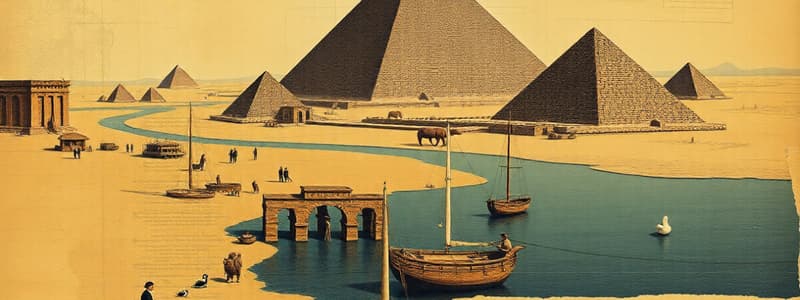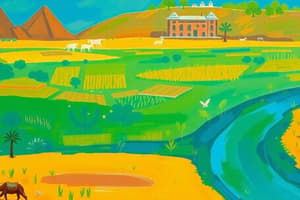Podcast
Questions and Answers
What can be inferred about the subject in the image based on their activity?
What can be inferred about the subject in the image based on their activity?
- They are writing a story about ancient Egypt.
- They are completing a homework assignment in mathematics.
- They are preparing for a physical education class.
- They are studying about ancient Egyptian culture. (correct)
Which of the following topics is likely discussed in the textbook shown in the image?
Which of the following topics is likely discussed in the textbook shown in the image?
- Technological advancements of the 21st century.
- The social structure of ancient Egyptian civilization. (correct)
- Modern architecture and design.
- The influence of the Renaissance on European art.
Considering the imagery in the textbook, which visual element is essential for understanding ancient Egyptian culture?
Considering the imagery in the textbook, which visual element is essential for understanding ancient Egyptian culture?
- Pictures of modern cities.
- Illustrations of ancient artifacts and monuments. (correct)
- Diagrams of current political systems.
- Photos of contemporary fashion trends.
Which aspect of the ancient Egyptians might be explored in the textbook, based on the images visible?
Which aspect of the ancient Egyptians might be explored in the textbook, based on the images visible?
Which activity is most likely encouraged by the presence of a textbook with visuals on ancient Egypt?
Which activity is most likely encouraged by the presence of a textbook with visuals on ancient Egypt?
What did the Egyptians believe about the soul after death?
What did the Egyptians believe about the soul after death?
What mathematical skill were the Egyptians particularly advanced in?
What mathematical skill were the Egyptians particularly advanced in?
How many extra days did the Egyptians add to their calendar at the end of the year?
How many extra days did the Egyptians add to their calendar at the end of the year?
What were the hieroglyphs used for in ancient Egypt?
What were the hieroglyphs used for in ancient Egypt?
What was the purpose of offerings made to the patron gods in Egyptian cities and villages?
What was the purpose of offerings made to the patron gods in Egyptian cities and villages?
How many months did the Egyptians divide their year into?
How many months did the Egyptians divide their year into?
What type of calendar did the Egyptians use?
What type of calendar did the Egyptians use?
What natural phenomenon did the Egyptians monitor in addition to the stars?
What natural phenomenon did the Egyptians monitor in addition to the stars?
How many days were in each month of the Egyptian calendar?
How many days were in each month of the Egyptian calendar?
Why were the Egyptians skilled in mathematics?
Why were the Egyptians skilled in mathematics?
What significant event marks the beginning of the Egyptian Civilization?
What significant event marks the beginning of the Egyptian Civilization?
Which of the following best describes the New Kingdom of Egyptian Civilization?
Which of the following best describes the New Kingdom of Egyptian Civilization?
How did the Nile River contribute to the sustenance of ancient Egyptian civilization?
How did the Nile River contribute to the sustenance of ancient Egyptian civilization?
What plant did ancient Egyptians utilize to produce a paperlike material for writing?
What plant did ancient Egyptians utilize to produce a paperlike material for writing?
What does the term 'Iters' mean in relation to the Nile?
What does the term 'Iters' mean in relation to the Nile?
What contributed significantly to the decline of the Egyptian Civilisation around 1100 BCE?
What contributed significantly to the decline of the Egyptian Civilisation around 1100 BCE?
Which event is noted as having a particularly negative impact on the treasury of Egypt?
Which event is noted as having a particularly negative impact on the treasury of Egypt?
Which group invaded Egypt before it became a province of the Roman Empire in 30 BCE?
Which group invaded Egypt before it became a province of the Roman Empire in 30 BCE?
What does the decline of the Egyptian Civilisation illustrate about the role of leadership during its final years?
What does the decline of the Egyptian Civilisation illustrate about the role of leadership during its final years?
Based on the information, how can the treatment of women in ancient Egypt be best characterized?
Based on the information, how can the treatment of women in ancient Egypt be best characterized?
Which cities were major centers of the Indus Valley Civilisation and were excavated by the Archaeological Survey of India?
Which cities were major centers of the Indus Valley Civilisation and were excavated by the Archaeological Survey of India?
What role did the Archaeological Survey of India (ASI) play concerning the Indus Valley Civilisation?
What role did the Archaeological Survey of India (ASI) play concerning the Indus Valley Civilisation?
During which time period did the Indus Valley Civilisation flourish?
During which time period did the Indus Valley Civilisation flourish?
What does the term 'Harappan Civilization' refer to?
What does the term 'Harappan Civilization' refer to?
Which archeological site is indicated as the first discovery site of the Indus Valley Civilisation?
Which archeological site is indicated as the first discovery site of the Indus Valley Civilisation?
What was a significant feature of the Harappans' cities?
What was a significant feature of the Harappans' cities?
Which statement accurately describes the Harappan drainage system?
Which statement accurately describes the Harappan drainage system?
What role did Harappan cities play in ancient India?
What role did Harappan cities play in ancient India?
Which of the following statements about Harappan houses is correct?
Which of the following statements about Harappan houses is correct?
What unique aspect of Harappan culture contributed to communication?
What unique aspect of Harappan culture contributed to communication?
What is one proposed purpose of the Great Bath in Mohenjo-daro?
What is one proposed purpose of the Great Bath in Mohenjo-daro?
What significant feature surrounds the Great Bath in Mohenjo-daro?
What significant feature surrounds the Great Bath in Mohenjo-daro?
What system was specifically well-built in relation to the Great Bath?
What system was specifically well-built in relation to the Great Bath?
Which of the following is NOT considered one of the important sites of the Indus Valley Civilization?
Which of the following is NOT considered one of the important sites of the Indus Valley Civilization?
What is a unique architectural feature of the Great Bath?
What is a unique architectural feature of the Great Bath?
What was a primary source of food security for the people of the Indus Valley Civilisation?
What was a primary source of food security for the people of the Indus Valley Civilisation?
Which animal was NOT likely domesticated by the people of the Indus Valley Civilisation?
Which animal was NOT likely domesticated by the people of the Indus Valley Civilisation?
How did the clothing styles differ among the people of the Indus Valley Civilisation?
How did the clothing styles differ among the people of the Indus Valley Civilisation?
Which of the following statements accurately describes the occupations in the Indus Valley Civilisation?
Which of the following statements accurately describes the occupations in the Indus Valley Civilisation?
What types of materials were commonly used in the jewellery of the Indus Valley Civilisation?
What types of materials were commonly used in the jewellery of the Indus Valley Civilisation?
What does the term 'Gift of Nile' refer to?
What does the term 'Gift of Nile' refer to?
How did ancient Egyptians adapt their farming techniques?
How did ancient Egyptians adapt their farming techniques?
Which of the following describes a critical architectural achievement of ancient Egyptians?
Which of the following describes a critical architectural achievement of ancient Egyptians?
What role did the Nile River play in trade for ancient Egyptians?
What role did the Nile River play in trade for ancient Egyptians?
Which belief system influenced the construction of temples in ancient Egypt?
Which belief system influenced the construction of temples in ancient Egypt?
What materials did ancient Egyptians commonly use for storage of food?
What materials did ancient Egyptians commonly use for storage of food?
Which of the following best describes the legacy left by ancient Egyptians?
Which of the following best describes the legacy left by ancient Egyptians?
What tools did ancient Egyptians develop to aid in farming?
What tools did ancient Egyptians develop to aid in farming?
Flashcards are hidden until you start studying
Study Notes
The Birth of Egyptian Civilization
- Egyptian Civilization originated around 3200 BCE with Pharaoh Menes (Narmer) unifying Upper and Lower Egypt.
- The civilization thrived until the death of Queen Cleopatra in 30 BCE.
Phases of Egyptian Civilization
- Characterized by periods of stability and conflicts, known as intermediate periods.
- The New Kingdom was an era of empire expansion, marked by significant conquests and cultural achievement.
Gift of the Nile
- The Nile is the longest river at 6,500 km, beginning in Lake Victoria and flowing to the Mediterranean Sea.
- Its annual floods provided fertile alluvial silt, essential for agriculture and cattle rearing.
- The river ensured a reliable water source and facilitated transportation and fishing, earning it the title "gift of the Nile" from Herodotus.
- Egyptians created writing materials from papyrus, a plant abundant in the riverbanks.
Egyptian Society
- Each city and village had a patron god representing specific aspects of life, with daily offerings and prayers performed.
- Life after death was a vital concept; Egyptians believed in a spiritual journey for the soul.
Mathematics and Astronomy
- Egyptians made advances in mathematics, especially geometry, using it for various practical applications like measuring the Nile's level.
- They developed a solar calendar with a 365-day year and five extra days, reflecting their observations of celestial movements.
Decline of Egyptian Civilization
- Decline began around 1100 BCE due to internal rebellions and foreign invasions, notably from Babylonians and later Roman forces.
- Pharaoh Ramses III's campaigns against Syria, Assyria, and Persia also led to weakened defenses.
- By 30 BCE, Egypt became a Roman province after substantial invasions and economic depletion.
Society and Gender Roles
- Ancient Egypt was predominantly patriarchal, but some women held significant power and ruled.
- The treatment of women varied; while some were respected, not all enjoyed equal status.
Indus Valley Civilization Overview
- Flourished between 2500 BCE and 1500 BCE along the Indus River, known for urban settlements.
- Major centers included Harappa and Mohenjo-daro, discovered in the 1920s by archaeologists.
Harappan Features and Architecture
- Advanced city planning with grid patterns, wide streets, and drainage systems to prevent flooding.
- Developed a writing system using symbols and excelled in crafts like pottery and metalwork.
Great Bath of Mohenjo-daro
- Appears as a swimming pool with surrounding galleries, potentially serving community or religious purposes.
- Constructed with an advanced drainage system.
Daily Life in the Indus Valley
- Diet comprised grains, fruits, vegetables, and spices, with farming being a primary occupation.
- Attire varied, with woolen fabrics common and jewelry made from various materials.
- Domesticated animals played a role in agriculture, transport, and companionship.
Importance of the Nile Valley
- The Nile Valley is fundamental to ancient Egyptian agriculture, providing fertile soil and essential resources.
- Ancient Egyptians mastered irrigation and canal systems for effective farming in arid regions, laying the foundations for ongoing agricultural practices.
- Their architectural achievements and vibrant culture have left a lasting legacy that continues to influence modern society.
Studying That Suits You
Use AI to generate personalized quizzes and flashcards to suit your learning preferences.




